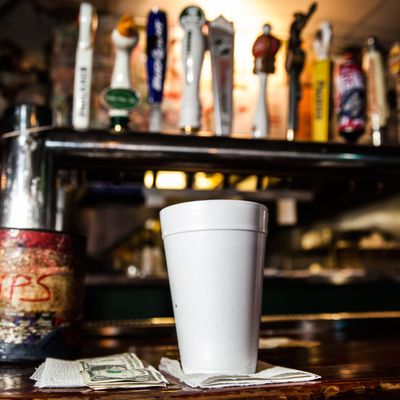
A New York City bar that still serves its beer in a big, white Styrofoam cup recalls an earlier time, when the city was one of the country’s manufacturing hubs, there was no such thing as an “ironic” dive bar, and Budweiser really was the king of beers. Foam cups keep beer cold, they’re big — 32 ounces — so customers never feel cheated, and most important, they’re really cheap. And now, they’re going away.
Technically, the cheap foam food containers that everyone thinks of as “Styrofoam” are made of a type of polystyrene; their lightweight construction makes them easy to break apart, and recycling concerns have led places like Seattle; Portland, Maine; Portland, Oregon; and dozens of California municipalities to enact bans on the food containers, moves that have largely been hailed as environmental successes. To deal with the 28,000 tons of soft foam that wind up in New York City’s landfills each year, a similar ban will go into effect here tomorrow. When it does, in addition to wiping out takeout containers and plates, the few remaining dive bars that still serve beer in foam cups will also be forced to find alternatives, effectively ending one of the last vestiges of the city’s pre-Giuliani years.
Back before ecoconcerns, in the days when the subway still required tokens and nobody had ever considered turning the High Line into a park, New York’s dives would regularly sell their Bud or Carling Black Label in cardboard cups, which were at the time simply the most cost-effective containers. Not only were they inexpensive, but owners didn’t have to pay anyone to clean them — a customer finished the beer, chucked the cup, and ordered another. Of course, the main drawback was that drinkers only had about 15 minutes to finish their beers before the cups’ bottoms would fall out, which was a problem, so dive owners started looking for another, similarly cheap option.
Enter expanded polystyrene — Styrofoam’s distant cousin — which was just as cheap, kept beer colder, and, crucially, didn’t bottom out. At Jeremy’s, in the Seaport, owner Jeremy Holin has been selling beer in 32-ounce foam cups (otherwise known as buckets) for 40-plus years, hosting a happy hour at 8 a.m. for off-the-clock dock workers. “I would sell those buckets for a buck,” Holin says. “Where else could you get a quart of beer for a dollar at 8 a.m.?” Still, at some point, didn’t he consider switching to beer in cans or even bottles? “I’m 69 years old,” he says. “and I’m not into change.”
Today, there are three other bars in the city where styrofoam cups are, or were until very recently, the norm: Farrell’s near Windsor Terrace, Rosemary’s Greenpoint Tavern, and the Turkey’s Nest in Williamsburg. Each bar started out as a watering hole for working-class locals, nothing more than a place to unwind after a long shift. They’re bars where there isn’t any rush to change or update things. “Farrell’s has used the foam containers since 1965, when I first started bartending here,” says Jim Houlihan, now a Farrell’s co-owner. “We have never even thought of taking it off the menu.”
Soon, they’ll have to. A lawsuit, filed in late April by the Restaurant Action Alliance and Dart Container Corporation (which makes the foam cups used by the bars), alleges the city knows about but did not consider an alternative plan to recycle New York’s foam. That suit could end up reversing the ban at some point in the future, but in the meantime, these bars have to find different cups.
Nobody seems very happy about that. At Farrell’s, the large cups serve double-duty, topped off with a plastic lid and used as makeshift to-go containers for customers who want to drink their cold Budweiser (the only beer Farrell’s serves) at home. “I have customers that have been coming here for 40 or 50 years, and they are shocked.” Houlihan says. The bar has ten cases of the 32-ounce cups left, a supply that should take them through September. Houlihan plans to use them until they run out — until January 1, the city will only issue warnings to businesses that still used styrofoam, after which point they’ll be fined — then figure out an alternative. “Whatever we buy is going to cost a lot more money,” Houlihan says.
Steve Ehresman, owner of the Turkey’s Nest, is stumped, too, though he plans to fully cooperate with the ban to avoid any interference from the city. “People are going to complain, but I’ve got no choice,” he says. “I’m going to test several different cups in the next two weeks, and find which keeps the beer cold best and is still cheap.” Ehresmen, too, points out that any ecofriendly alternative is going to be pricier. “It’s like organic food,” he says. “Everything costs double.”
Rosemary’s started to phase out its foam cups when the ban was announced in early January, and even Holin has begun updating Jeremy’s, adding a new dishwasher, hiring more staff, and even ordering cases of 32-ounce mason jars, something usually found holding drinks at farm-to-table-type establishments in gentrified neighborhoods. For Holin, though, the jars aren’t about chasing trends; they’re purely utilitarian. “We thought about ordering mugs,” he says, “but then we figured people would steal them.”




